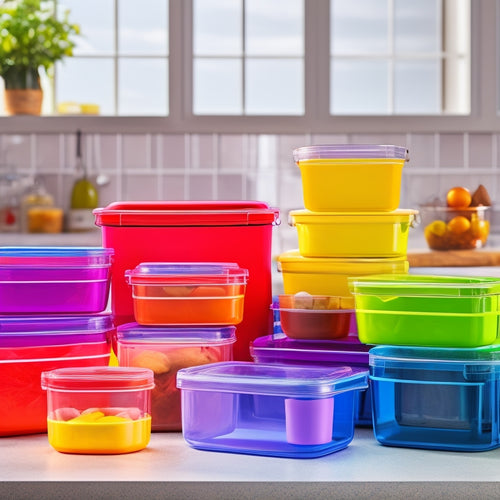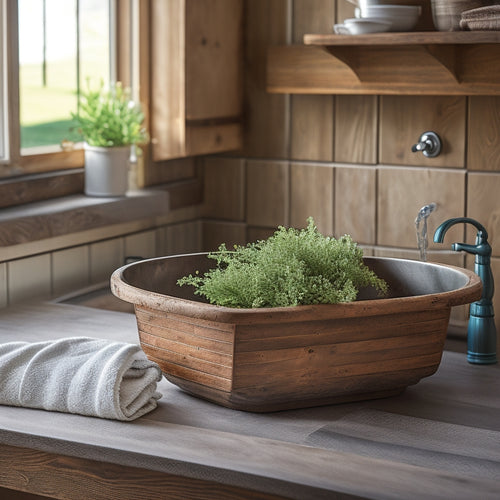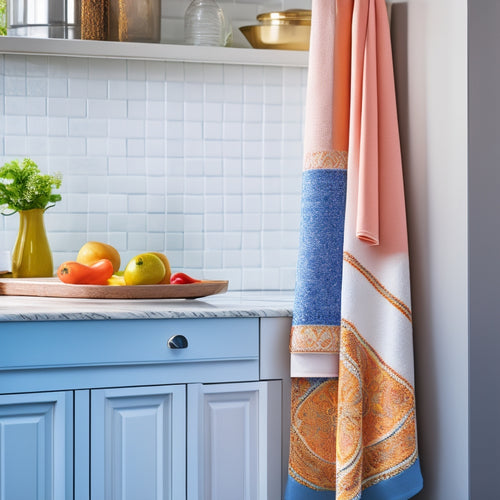
3 Best Aging-in-Place Kitchen Layout Ideas
Share
You're creating a kitchen that will adapt to your changing needs as you age. To achieve this, focus on universal design principles, incorporating contrast sensitivity, task lighting, and flexible fixtures for best functionality. Next, design an open layout that allows for easy navigation and conversation while cooking, featuring curved pathways and seamless flow between kitchen zones. Finally, prioritize smart storage solutions, like pull-out shelves, adjustable countertops, and wall-mounted storage, to guarantee accessibility and elegance in your kitchen. As you explore these ideas further, you'll uncover the perfect blend of form and function that suits your evolving style.
Key Takeaways
• Prioritize universal design principles to create an accessible kitchen for all ages and abilities.
• Opt for an open layout with curved pathways to enable easy navigation with mobility aids.
• Incorporate smart storage solutions, such as pull-out shelves and lazy susans, for convenient access to essentials.
• Ensure task lighting is installed in specific areas to enhance visibility and safety.
• Design with flexibility in fixtures and furniture to accommodate changing needs over time.
Universal Design Principles
As you design your aging-in-place kitchen, incorporating universal design principles guarantees a space that's both beautiful and accessible, regardless of age or ability. It's all about creating a harmonious blend of form and function.
To achieve this, focus on contrast sensitivity. Make sure that there's sufficient visual contrast between different elements, such as countertops, cabinets, and flooring. This makes it easier for users with visual impairments to navigate the space. For instance, use light-colored countertops with dark-colored cabinets or vice versa.
Additionally, consider installing task lighting to highlight specific areas, like the cooking zone or sink area. Flexible fixtures are another vital aspect of universal design. Opt for adjustable shelves, pull-out cabinets, and touchless faucets that can be easily operated with minimal effort. This enables users with mobility or dexterity issues to access and use the kitchen facilities with ease.
Open Layout for Easy Navigation
By opting for an open layout, you'll create a seamless flow between kitchen zones, allowing you to glide effortlessly from cooking to cleaning, and back again, without obstacles getting in the way.
This open concept design enables you to move freely and comfortably, reducing fatigue and strain. Imagine being able to converse with family and friends while cooking, fostering a sense of community and social cooking.
The absence of narrow corridors and tight corners also makes it easier to navigate with mobility aids, if needed.
To enhance the open layout, consider incorporating curved pathways that guide you smoothly from one area to another. These gentle curves create a sense of flow, making it easier to move around the kitchen. Plus, they add a touch of elegance and sophistication to the space.
Smart Storage for Accessibility
In your aging-in-place kitchen, clever storage solutions become an essential component, ensuring that essential cooking tools and utensils are always within easy reach, reducing strain and effort. This means you can focus on cooking and enjoying meals with loved ones, rather than struggling to find what you need.
Here are some smart storage ideas to make your kitchen more accessible:
-
Pull out shelves: install shelves that slide out smoothly, allowing you to easily access heavy pots, pans, and cookbooks without straining your back.
-
Adjustable countertops: design your countertops to be adjustable in height, making it easy to work comfortably while standing or sitting.
-
Drawer organizers: use dividers and inserts to keep utensils, spices, and other essentials organized and within reach.
-
Wall-mounted storage: hang frequently used items like pots, pans, and utensils on the wall, freeing up counter space and making them easy to access.
-
Lazy susans: add rotating trays in corner cabinets or on countertops, allowing you to easily access items in hard-to-reach areas.
Frequently Asked Questions
How Can I Incorporate Assistive Technology Into My Kitchen Design?
You'll seamlessly integrate assistive technology into your kitchen design by incorporating smart appliances with voice controls, allowing you to effortlessly adjust settings, access recipes, and control lighting with simple voice commands, enhancing independence and accessibility.
What Are the Benefits of Using a Kitchen Cart for Aging-In-Place?
"Imagine a trusty knight, standing guard in your kitchen, ready to serve. That's what a thoughtfully placed kitchen cart can be, offering flexible storage options and effortless access, so you can focus on serving others with ease and care."
Can I Still Have a Beautiful Kitchen With Aging-In-Place Features?
You don't have to sacrifice style for accessibility; with creative luxury adaptations, you can achieve a gorgeous kitchen that exudes elegance, making no aesthetic compromise, while still catering to the needs of aging individuals.
How Do I Choose the Right Type of Flooring for an Aging-In-Place Kitchen?
Imagine yourself standing in a warm, inviting kitchen, where every step feels secure. You'll want to choose flooring that's both beautiful and safe. Opt for slip-resistant materials like textured ceramic, rubber, or cork, which provide traction and comfort underfoot.
Are There Any Specific Aging-In-Place Kitchen Layout Ideas for Small Kitchens?
In your small kitchen, you'll want to prioritize space savers like wall-mounted shelves and compact appliances. Corner solutions, such as carousels or lazy susans, will also help maximize every inch, creating a functional and beautiful space.
Related Posts
-

Stackable Kitchen Containers for Modular Systems
Stackable kitchen containers for modular systems change your cooking space by maximizing vertical storage and enhanci...
-

Sink Caddy Organizers for Farmhouse Style Kitchens
Sink caddy organizers are perfect for elevating your farmhouse-style kitchen while keeping it functional. You'll love...
-

Over-The-Door Kitchen Towel Holder
An over-the-door kitchen towel holder is a smart way to maximize your space while keeping towels easy to grab. It hoo...


